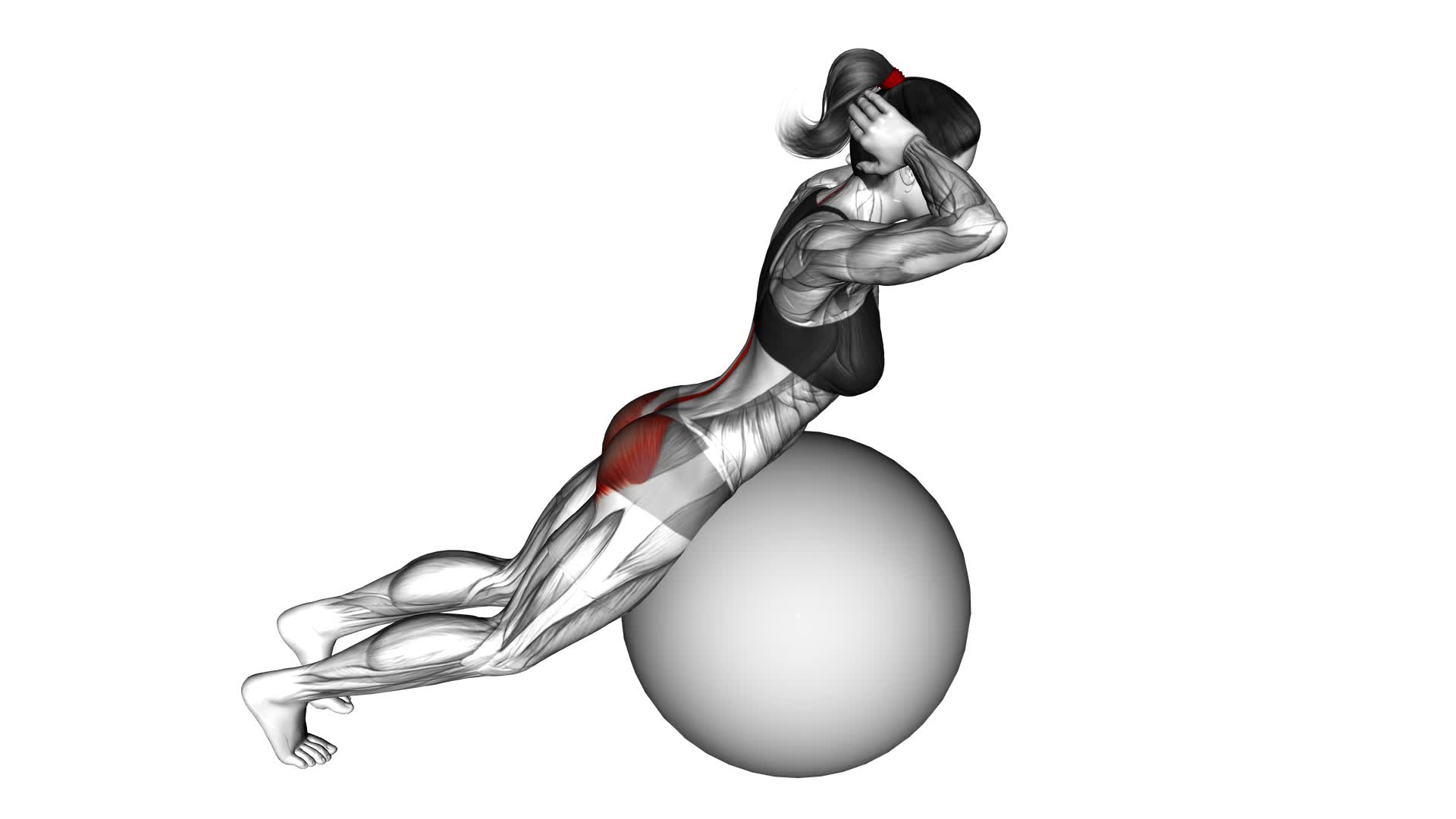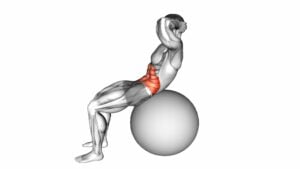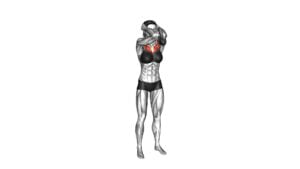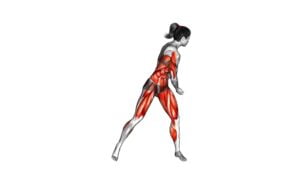Exercise Ball Back Extension With Hands Behind Head (female) – Video Exercise Guide & Tips

Get ready to strengthen your back with the exercise ball back extension. In this video guide, you'll learn the proper form and variations to increase intensity.
Watch This Exercise Video
With hands behind your head, you'll engage your core and target those hard-to-reach muscles. Follow these tips for a safe and effective workout, and discover how to incorporate this exercise into your routine.
Let's get started!
Key Takeaways
- Exercise ball back extensions with hands behind the head help maintain correct posture and strengthen the muscles that support the spine.
- These exercises reduce the risk of injuries, improve core strength, and enhance balance and stability.
- They also improve posture and spinal alignment, increase flexibility and range of motion in the back, and engage core muscles for a full-body workout.
- Beginners can modify the exercise by starting with smaller movements and gradually increasing the range of motion, while advanced individuals can add resistance or use different hand positions for targeting specific muscle groups.
Benefits of Exercise Ball Back Extension
You will experience numerous benefits from incorporating exercise ball back extensions into your workout routine. One of the key benefits is the importance of proper posture during exercise. By performing back extensions on an exercise ball, you're forced to maintain a correct posture throughout the movement. This helps to strengthen the muscles that support your spine, improving overall posture and reducing the risk of injuries.
Additionally, exercise ball back extensions are highly effective in improving core strength. As you extend your back on the ball, your core muscles, including your abdominals and lower back, are engaged to stabilize your body. This not only strengthens your core, but also helps to improve balance and stability.
By incorporating exercise ball back extensions into your workout routine, you won't only improve your posture and core strength, but also enhance your overall fitness level. It's important to note that proper form is crucial when performing this exercise.
Transitioning into the subsequent section about proper form for exercise ball back extensions, let's discuss the correct technique to ensure maximum benefits and minimize the risk of injury.
Proper Form for Exercise Ball Back Extension
To ensure proper form and maximize the benefits of exercise ball back extensions, it's important to consistently perform the exercise with correct technique. One common mistake during exercise ball back extensions is arching the lower back too much, which can put excessive strain on the spine. To avoid this, engage your core muscles and maintain a neutral spine throughout the movement. Another mistake is using momentum to lift your upper body instead of relying on your back muscles. To fix this, focus on using your back muscles to initiate the movement and lift your upper body.
It is also important to avoid pulling on your neck or placing your hands behind your head during the exercise. Instead, place your hands lightly on the sides of your head or cross them over your chest to maintain proper alignment and prevent strain on your neck and upper back.
If you find the exercise ball back extension too challenging or uncomfortable, there are alternative exercises you can try. These include the traditional back extension on a flat surface, the Superman exercise, or the bird dog exercise. These exercises target the same muscles as the exercise ball back extension but may be more suitable for individuals with limited mobility or lower back pain.
Remember to always consult with a healthcare professional before starting any new exercise program, especially if you have any pre-existing conditions or injuries.
Variations to Increase Intensity
To increase the intensity of the exercise ball back extension, incorporate advanced variations that challenge your core and back muscles further. Here are some weighted variations and advanced modifications you can try:
- Weighted Back Extension: Hold a dumbbell or a weighted plate against your chest while performing the back extension. This added weight will increase the resistance and make your muscles work harder.
- Single-Leg Back Extension: Perform the exercise with one leg lifted off the ground. This variation not only increases the difficulty but also adds an element of balance and stability, engaging more muscles in your core and back.
- Arms Overhead Back Extension: Instead of placing your hands behind your head, extend your arms overhead while performing the exercise. This modification increases the demand on your upper back muscles and can help improve your posture.
Incorporating these weighted variations and advanced modifications into your exercise routine will help you take your exercise ball back extension to the next level. Remember to start with lighter weights or easier variations and gradually increase the intensity as your strength and stability improve.
Tips for a Safe and Effective Workout
To ensure a safe and effective workout, follow these essential tips for maximizing the benefits of the exercise ball back extension.
First and foremost, it's important to choose the right equipment. While the exercise ball is highly recommended, if you don't have access to one, alternative options such as a stability ball or a yoga ball can be used. Just make sure it's the right size for your height and weight.
When performing the exercise ball back extension, it's crucial to maintain proper form. Common mistakes to avoid include using momentum to lift your upper body, rather than relying on your back muscles. Also, be mindful not to strain your neck by pulling on it with your hands. Instead, keep your hands gently placed behind your head, providing support but not pulling.
Another important tip is to start with a lighter weight or resistance and gradually increase as your strength improves. This will help prevent any unnecessary strain on your back and reduce the risk of injury.
Now that you're aware of these tips, you can confidently incorporate the exercise ball back extension into your routine.
Incorporating Exercise Ball Back Extension Into Your Routine
To incorporate the exercise ball back extension into your routine, start by adding it as a compound exercise to target your back muscles and improve overall strength. This exercise is highly beneficial and can help you achieve maximum results when performed correctly. Here's how to properly perform the exercise ball back extension for maximum benefits:
- Begin by lying face down on the exercise ball, with your hips resting on top of the ball and your feet firmly planted on the ground.
- Place your hands behind your head, with your elbows pointing outwards.
- Engage your core muscles and slowly lift your upper body off the ball, extending your back as you do so. Be sure to keep your neck aligned with your spine.
- Pause for a moment at the top of the movement, then slowly lower your body back down to the starting position.
- Repeat for the desired number of repetitions, ensuring that you maintain proper form throughout the exercise.
Incorporating the exercise ball back extension into your routine offers several benefits. It helps strengthen your back muscles, improves posture, and enhances overall stability. Additionally, this exercise engages your core muscles, providing a full-body workout.
Frequently Asked Questions
Can I Perform the Exercise Ball Back Extension Without an Exercise Ball?
Yes, you can perform alternative exercises if you don't have an exercise ball. However, it's important to note that using an exercise ball for back extensions offers unique benefits.
The exercise ball provides stability and engages your core muscles, allowing for a greater range of motion and increased challenge.
Without the exercise ball, you may not get the same level of engagement and effectiveness. Consider using a substitute like a bench or stability cushion to mimic the stability and benefits of the exercise ball.
How Many Reps and Sets Should I Do for the Exercise Ball Back Extension?
To get the most out of the exercise ball back extension, it's important to know the recommended number of reps and sets.
The benefits of this exercise include strengthening your lower back and improving your posture.
As for variations, you can try performing the back extension with your hands on your chest or with a weight held against your chest for added resistance.
Remember to start with a weight and number of reps that challenge you without causing strain.
Can I Do the Exercise Ball Back Extension if I Have Lower Back Pain?
If you're experiencing lower back pain, it's important to find alternative exercises that provide relief.
The exercise ball back extension may not be the best choice for you. However, there are modifications you can make to provide more support.
Consider doing the exercise with your hands on your thighs instead of behind your head. This will reduce the strain on your lower back.
Always listen to your body and consult with a medical professional if you have any concerns.
Is It Normal to Feel Discomfort in My Neck While Performing the Exercise Ball Back Extension?
Feeling discomfort in your neck during the exercise ball back extension isn't normal. It may be a sign of improper neck alignment during the exercise.
To alleviate this discomfort, try modifying the exercise by placing your hands on the sides of your head instead of behind it. This can help maintain a neutral neck position and reduce strain.
Remember to listen to your body and stop if the discomfort persists or worsens.
Can I Use Weights or Resistance Bands to Increase the Intensity of the Exercise Ball Back Extension?
You can definitely increase the intensity of the exercise ball back extension by using weights or resistance bands. Adding weights or resistance bands will challenge your muscles more and help you build strength. You can try holding a dumbbell or placing a resistance band around your shoulders while performing the exercise.
Alternatively, you can explore other exercises like supermans or hyperextensions that target the same muscle groups. Remember to start with lighter weights or resistance and gradually increase as you get stronger.
Conclusion
Incorporating exercise ball back extensions into your routine can provide numerous benefits, including improved back strength and posture. By maintaining proper form and gradually increasing intensity, you can maximize the effectiveness of this exercise.
Remember to always prioritize safety and consult with a professional if needed. So grab your exercise ball and start incorporating this exercise into your fitness routine for a stronger and healthier back.

Author
Years ago, the spark of my life’s passion ignited in my mind the moment I stepped into the local gym for the first time. The inaugural bead of perspiration, the initial endeavor, the very first surge of endorphins, and a sense of pride that washed over me post-workout marked the beginning of my deep-seated interest in strength sports, fitness, and sports nutrition. This very curiosity blossomed rapidly into a profound fascination, propelling me to earn a Master’s degree in Physical Education from the Academy of Physical Education in Krakow, followed by a Sports Manager diploma from the Jagiellonian University. My journey of growth led me to gain more specialized qualifications, such as being a certified personal trainer with a focus on sports dietetics, a lifeguard, and an instructor for wellness and corrective gymnastics. Theoretical knowledge paired seamlessly with practical experience, reinforcing my belief that the transformation of individuals under my guidance was also a reflection of my personal growth. This belief holds true even today. Each day, I strive to push the boundaries and explore new realms. These realms gently elevate me to greater heights. The unique combination of passion for my field and the continuous quest for growth fuels my drive to break new ground.



